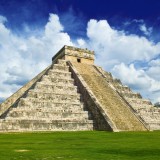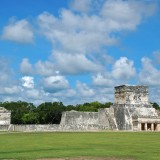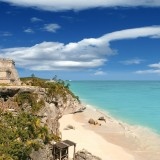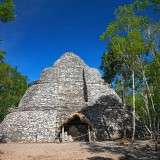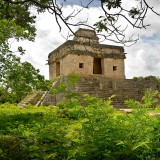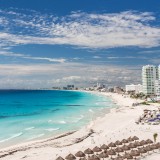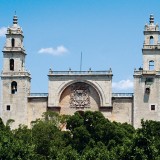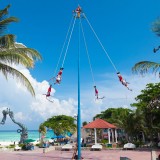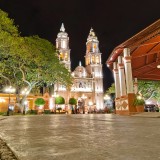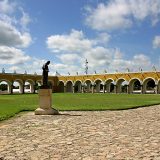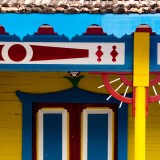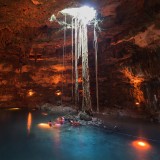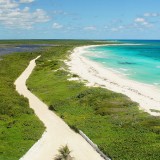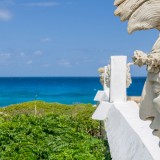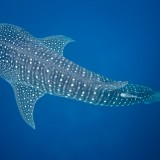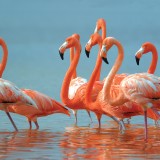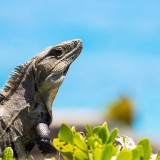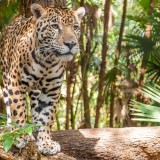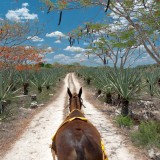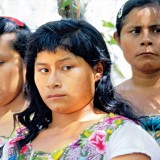loading
Tulum, archaeological site









San Gervasio












Ek Balam












(Video: INAH TV)
Dzibilchaltun








(Video: INAH TV)
Coba
Chichen Itza












Xcambó
Surrounded by marshland, Xcambó was a salt and trading port controlled by Izamal. Xcambo has small houses and platforms, in addition to ceremonial structures such as the Pyramid of Masks, the Pyramid of the Cross and the Temple of Sacrifices.
(Video: Perspectiva natural)
Xpuhil
This small site flourished between 400 B.C. and 1100 A.D. It is famous for Building I or the Building of the Three Towers of Group 1, built during the Late Classic, with stairs decorated with three masks representing felines, probably the sacred jaguar.
(Video: Mystic Places. Freedompressnews)
Uxmal












Mahahual
A quaint fishing village until the end of the 20th Century, between Punta Herrero and Xcalak, Mahahual has become a tourist destination for alternative tourism and it is also an international cruise ship terminal. At Mahahual, you can practice water sports such as sailing, snorkeling and sport fishing. There are stores, restaurants, accommodation, a pier and an airstrip nearby. Tours are available to different tourist attractions in the area: a dolphinarium, the Bay of Chetumal, Bacalar, and the archaeological sites of Kohunlich, Dzibanche, Chacchoben and Chakanbakan.
(Video: Secretaría de Turismo del Estado de Quintana Roo)
Izamal
Isla Mujeres
Holbox












Located in the northern part of the state of Quintana Roo, the island of Holbox is about 40 km long and 2 km wide in its widest part. Its economy is based on fishing and tourism. The town is rustic and friendly, with palm-thatched huts and wooden houses. Small restaurants serve fresh seafood; there are cabañas (bungalows) for rent and low-impact tourist developments. The island boasts a fine stretch of powdery sand, ideal for sunbathing and beachcombing. Boat trips can be arranged to the Yalahau lagoon, Isla Pájaros, Isla Morada and the Ch´ich islet. Cabo Catoche is the northernmost point in the peninsula; that's the place where the Caribbean meets the Gulf of Mexico. Depending on the season, whale sharkd can be seen near its coast.
(Video: Secretaría de Turismo del Estado de Quintana Roo).
Hacienda Yaxcopoil
Founded in the 17th century, its name means “the place of the green poplars”. It is now a tourist parador and museum that aims at showing the atmosphere of that place at the height of its splendor. The main house is surrounded by gardens and there is a chapel dedicated to San Gerónimo de Yaxcopoil. The hacienda still has vestiges from Mayan structures and in one of the rooms there is an exhibition of archaeological pieces dating from 250 to 900 d.C.
(Video: Bryce Leverich)
Hacienda Temozón Sur
Temozón is a former henequen hacienda that provides hotel services with 28 exquisitely decorated rooms, located in the main building and surrounded by beautiful gardens. Hacienda Temozón belongs to a sustainable tourism project. Together with the Haciendas del Mundo Maya Foundation A.C., it supports projects meant to help the local communities.
(Video: eMaya)
Hacienda Sotuta de Peón
| This “Live Hacienda” was built at the end of the 19th century in Tecoh. Its restoration gives an accurate idea of what a fully operating henequen hacienda used to be, including the style and traditions of that time. This “Travel in time” starts when the visitors are transported on wood platforms on rails, called “trucks” and drawn by mules. Visitors can also visit a typical Mayan house and swim in a wonderful cenote or in the swimming-pool. |
(Video: In The Yucatan)
San José Cholul Hacienda
A historic hacienda that used to be a henequen plantation and now offers luxury hotel services. Hacienda San José Cholul is part of a sustainable tourism project, with a strong commitment towards nature and Mayan culture.
(Video: eMaya)
Felipe Carrillo Puerto
It was founded in 1850 as Chan Santa Cruz, the Maya rebel stronghold during the Caste War. In 1932, the town was renamed Felipe Carrillo Puerto after a governor of Yucatan with socialist ideas. Its major attractions are the main plaza, the cultural center, the Shrine of the Talking Cross and the Mayan ceremonies in its honor.
(Video: Secretaría de Turismo del Estado de Quintana Roo).
Cozumel
Campeche City
Chetumal
Champotón
Founded by the Itzaes, its colonial past is reflected in the Fort of San Antonio and the church of Our Lady of Mercedes. The Champoton River is ideal for sport fishing and eco-tourism. To the south, it is the starting point of an extensive stretch of beaches, such as Punta Xen and Chenkán.
(Video: eMaya.com)
Cancun
Bacalar
Magical Village. During the colonial period, it was a prosperous trade place, which became the target of every pirate in the area. You will find small restaurants as well as quiet hotels and cabins. The lagoon is known as the "lagoon of seven colors" and it is perfect for water sports. The fort of San Felipe, home to the Museum of Regional History, and the beautiful Blue Cenote are very close to Bacalar.
(Video: Postandfly)
Xplor








A unique underground world awaits discovery and a range of activities that will thrill your very being. Sail down stalactite-filled rivers on board a raft, go swimming, take to the water in amphibian jeeps or try zip lining through the jungle canopy.
(Video: Xplor)
Xoximilco
| Xoximilco is the perfect place for a party aboard the colorful trajineras that remind each and every state of Mexico. Tour the canals that make up Xoximilco while you hear live mariachi music and enjoy Mexican music and tequila |
(Video: Xoximilco)
Xel-Há






In the largest natural lagoon in the world, you can actually swim as if you were in an “aquarium.” The main tour begins at the mouth of a transparent river, and it ends at the far side of the inlet that was also a Mayan port. The fish never leave you alone!
(Video: Xel-Há)
Xcaret
Mesoamerican Reef












The Mesoamerican Barrier Reef System (SAM) is the world's second largest reef. It stretches along the Caribbean coast of Mexico, Belize, Guatemala and Honduras. It shelters an underwater world that is both complex and fragile. Many forms of life develop on the reef: more than 500 species of fish, in addition to lobsters, conches, turtles, sponges, sea urchins, algae, and starfish, among others.
(Video: Kip Evans / Mission Blue Foundation)
Puerto Morelos Cenote Route










Along the 37 kilometers (23 miles) from the beginning of the route (at Highway 307) to Leona Vicario, there is a zigzag line of crystalline-water deposits referred to as the Cenote Route with parks featuring a variety of activities, such as cave diving, snorkeling, zip lines and tours on bikes, horseback and ATVs, Temazcal ceremonies (indigenous steam baths), among other things. The following cenotes are of importance: Boca del Puma, Las Mojarras, Verde Lucero, Selvatica, Kin-Ha and Xenotes.
(Video: Productora Rincones de mi Tierra, The Mayan Route)
Rio Secreto






Located in a natural protected area, a trip through this intriguing underground route, on a safe, guided tour – while walking and swimming – is like a trip through time in a surreal atmosphere of infinite stalactites and stalagmites. Equipment and lunch are included.
(Video: Río Secreto)
Ria Lagartos












In northeastern Yucatan, there are two coastal towns within 10 kms. (about 6 miles) of each other, where most of the residents are fishermen, with an ever-increasing interest in ecological tourism: San Felipe and Rio Lagartos. They offer boat tours through Ría Lagartos to observe numerous birds like the pink flamingos, and crocodiles in the mangroves; in addition, there are saltworks and beaches.
(Video: Estrellas del Bicentenario, Televisa)
Ria Celestun








A Biosphere Reserve that covers around 600 km2 (373 sq. miles) between Campeche and Yucatan, with petrified forests, swamps, cenotes and a beautiful estuary where flamingos abound. The town of Celestún, 90 kms. (56 miles) from Mérida, is connected to the mainland by a bridge, where boat trips take off to observe the flamingos.
(Video: The Mayan Route)
Punta Laguna
Some 20 kms. (12.4 miles) west of Cobá, the community of Punta Laguna is part of a 5,000-hectare nature reserve: Ma´ax Yetel Kooh, which means "House of the spider monkey and the jaguar" in maya. It’s a true ecological oasis boasting a huge lagoon and spider monkeys (that can be seen especially at sunrise and sunset). Local guides offer tours, and one can also take a tour on a canoe, try ziplining or explore a cenote.
(Video: Martin Balog)
Sian Ka’an Reserve










Sian Ka´an (meaning “where the sky is born” in Maya) has been declared UNESCO World Heritage Site. Its over 500 000 hectares encompass most of the ecosystems that exist in the Yucatan Peninsula, from mangroves, medium and low-growth jungles, savannas, coastal lagoons, cenotes, marshes, coastal dunes, sand banks and coral reefs. In Tulum or in the community of Chunyaxche, you can book tours that include navigating along its canals, surrounded by mangroves. Tours are operated by local Ecotourist Services Cooperatives.
(Video: The Mayan Route)
Native’s Park
They offer quad tours on the paths of the mayan jungle in a natural protected area. On the way, you can explore caves, Mayan vestiges, learn about this ancient culture, swim in a crystal-clear cenote and learn how these natural wonders were formed.
(Video: Alltournative - Canal Janet Zarate)
Belize City






The largest city in Belize, with a population of around 80,000, it is located at the mouth of the Belize River, on the Caribbean Sea coast. It is the main harbour in the country. You can visit its casino and the Belize Museum (museum of art and history), the Saint John Cathedral and the Cultural Center. The city is a mix of rustic Caribbean flair and modern architecture. Some of the nearby attractions include the Belize zoo, San Pedro and the Altun Ha archaeological site.
(Video: Belize City Tours Video, Canal: Annmarie Craig)
Discover Mexico Park










Chikin Ha Park










Contoy Island
Also known as "the birds island", Contoy is a national park located north of Cancun. The island is near 9 km long and an average 500 meters wide and is home to over 150 migratory and resident bird species, such as frigate birds, roseate spoonbills, cormorants, pelicans, white ibis and swallows. During the summer, the hawksbill, green and loggerhead turtles come ashore to lay their eggs. To get there, there are day trips from Cancun, Puerto Juarez and Isla Mujeres for up to a maximum of 200 visitors a day. There is a small museum, a viewpoint and an area to have lunch.
(Video: JCVdude)
Balankanche Caves
“The jaguar throne” is a 10-meter deep cave with three chambers where lots of objects have been found, such as clay incense burners, some representing the rain god; others are round, made of stone and adorned with warriers and dancers. There are also plates, jars, mortars and miniature stone hands. On the ground there are remains of a small mayan site.
(Video: Dora - UNILA)
Loltun Caves
| One way to get a closer look inside the earth is a visit to the Loltún caves (“Stone Flower” in Maya). These impressive rock formations stretch 10 kms. (6 miles) and have spacious galleries such as the Principal, the Grand Canyon and the Cathedral. Bison and mammoth skeletal remains, rock paintings, rock carvings and sculptures have been found. |
(Video: Alfredo LoGo)
Sayil
One of the most prominent buildings in Sayil is the Great Palace, a monumental, three-storey structure containing 94 rooms divided by columns. The latter include columns with capitals, small columns and friezes with masks and gods. A sacbe connects the complex to the two-storey South Palace, the ball court and a platform with carved stelae. Halfway along the sacbe stands El Mirador, a building associated with the ancient elite.
(Video: 307 Riviera Maya)
Santa Rosa Xtampak
Late Classic site. The main square houses the Palace, a rectangular, three-story building with 44 rooms, lateral temples with main squares adorned with small columns, bas-reliefs, eight stelae and remains of mural painting. The Chaac Temple features vestiges of the rain god masks.
(Video: Eduardo González)
Mayapan
Founded around 1250 A.D. it was the last great city built by the Maya of the Yucatan Peninsula before the Spaniards arrived. Buildings such as El Castillo and The Observatory are scale models of the buildings that bear the same name in Chichén Itzá. The city was abandoned around 1450 A.D, after a battle between rival Mayan groups. Some of the most important features of the site are the wall painting at the Temple of the Painted Niches and the warriors sculptures at El Castillo.
(Video: Perspectiva Natural)
Labna
It has a residential palace with three levels and a frieze decorated with symbolic and geometric elements. One of the corners has a serpent’s head out of whose jaws a man’s head emerges. The Palace is linked to the south by means of a sacbe that crosses the main square, ending in a pyramidal base topped with a temple near the Monumental Arch, which is decorated with geometric figures and masks.
(Video: Eduardo González)
Kabah




| The most important building is the Codz Poop ("rolled up mat"), located in the Palace Group, its facade is completely covered with fine limestone mosaic, and features approximately 250 Chaac masks, each made out of 30 tiles. The east facade is decorated with magnificent sculptures of the city’s ancient rulers. To the east of the complex lies a sober arch indicating the entrance to the city. |
(Video: INAH TV).
Hormiguero
Structure II has stucco decoration, two monumental towers, flanked by columns of Chaac masks with the triple symbol of life, earth and the underworld.
The zoomorphic entrance leading to the temple is impressive. Building II is decorated with bas-reliefs of god Itzamna.
(Video: LDLservices)
Dzibanche




| It owes its name (“writing on wood”) to the lintels with calendrical inscriptions found in the Temple of the Lintels. It reached its peak between 300 and 1200 A.D. Temples I and II are particularly outstanding. A tomb with sumptuous offerings was found in the former. Other buildings include the Temple of the Cormorants and the North and South plazas that form the Xibalba Patio, and Gann Square, where Building XIII or Building of the Captives can be seen. |
(Video: Caribe Mexicano)
Chicanna
In Chicanna most of the buildings date from the Late Classic. The Structure II, is built in the shape of a mask, perhaps Itzamna, as a reptile, the doorway symbolized the mouth.
(Video: Christopher Arnold)
Chakanbakan
| The most remarkable structure is the Nohoch Balam temple,built between 300 and 50 d.C. it has seven levels and masks representing divinities related to the jaguar, the sacred animal of the Maya. The Ukuchilbaxal is a complex of three structures that make up the Ball Game. Chakanbakán means “Surrounded by Savannah”. The site is not open to the public. |
(Video: Julio Torres).
Becan





| The central part of the city, whose name means “path of the serpent” is surrounded by a wall and a moat. The city, built between A.D. 200 and 600, covers 25 ha. The arrangement of the buildings suggests that its residents needed strong defenses and the city was built between A.D. 200 and 600. |
(Video: Mystic Places, Magical Mystery Tour)
Balamku






| Early pre-Classic site famous for the building known as the House of the Four Kings, which has a magnificent stucco frieze featuring earth monster masks, amphibians reminiscent of the water paradise, sovereigns on a level with the sun and jaguars symbolizing war, sacrifice and death. Balamku means Temple of the Jaguar. |
(Video: Toño Busqueta)
Cenotes of Miguel Colorado
Most of Campeche’s cenotes have yet to be explored, found in remote spots hidden amongst dense vegetation. Some 25 km. from Escarcega, in the community of Miguel Colorado, there are around 12 cenotes, such as Cenote Azul, Los Patos and K41.
(Video: The Mayan Route)
Cenotes de Cuzama








Cuzama is a municipality getting more popular every day due to its cenotes and due to the way to reach them: by a “truck” pulled by horses along seven kilometers (just over 4 miles) of tracks through pure nature trails, starting at the former Chunkanán henequen hacienda. The main ones are: Chelentun, Chak Zinik Che and Bolonchoojol.
(Video: José Luis Tisone)
Cenote Maya Park
This beautiful cenote is a 80 m-diameter natural pool, very close to Valladolid. Residents of the nearby Mayan communities work at the park. There are showers and food service.
(Video: Alltounative)
Cenote Dos Ojos










| Cenote Dos Ojos is one of the favorites among scuba divers because of the clarity of its waters, spectacular formations and the possibility of doing two different dives: the Barbie Line, 500 mts. long, and the Bat Cave Line, 450 mts. long, with a maximum depth of 10 mts. and with a temperature of 24°C (75°F). |
Yalkú Inlet
The inlet is located north of Akumal, on the road to Half Moon Bay. It is a great place for snorkeling, a freshwater system emerging from underwater rivers leads out to the ocean, mixing fresh and salt water. Limestone, mangroves and a few sculptures add a beautiful complement to the landscape. Yalkú is a Mayan word that means “animals´ nest”.
(Vidéo: Top Mexico Real State)
Banco Chinchorro










| Chinchorro is the largest atoll in Mexico and part of the second longest coral reef system in the world. It covers an area of approximately 500 sq. miles. The reef and its lagoon provide sport for both divers and snorkelers and just about every variety of coral is present, sponges come in all sizes, and along with tropical fish, are the reef’s most colorful inhabitants. Sea turtles feed on beds of sea grass, and barracuda, snapper, bass and grouper are in constant attendance. Chinchorro has three mangrove cays: Cayo Centro, Cayo Norte and Cayo Sur. For many, the biggest draw is Chinchorro’s catalogue of sunken ships. |
(Vidéo: INAH TV)
Valladolid
Tulum city and hotel zone










Still untouched by mass tourism, the small town of Tulum enjoys a simple and laid back way of life. It offers some coffee shops, bars, restaurants and local businesses. The hotel zone in Tulum is made of low impact bungalows, in harmony with the natural surrounding beauty.
(Video: Secretaría de Turismo del Estado de Quintana Roo)
Puerto Morelos










A small town known for its laid back atmosphere and wide variety of accommodation options. The major attraction there is the coral reef lying offshore, which has been declared a National Park. The town square is lined with small restaurants and stores as well as a handicrafts market. A little bit out of town, other attractions await visitors, such as a botanical garden, a crocodile farm and, inland, the Route of the Cenotes.
(Video: Secretaría de Turismo del Estado de Quintana Roo.
Progreso
Located on the Gulf of Mexico, 36 km north of Merida, the state capital, it is the main port of the state of Yucatan. Both a cruise ship port and a high-sea port, its beaches are among the favorite of Merida residents, especially during the summer. On the beaches of the Malecón – a one-kilometre long waterfront promenade – one can practice watersports and there are several tourist services.
(Video: DRFMT, Yucatán).

